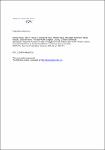Synergistic Adaptive Mutations in the Hemagglutinin and Polymerase Acidic Protein Lead to Increased Virulence of Pandemic 2009 H1N1 Influenza A Virus in Mice
Seyer, Roman
Hrincius, Eike R.
Ritzel, Dorothea
Abt, Marion
Mellmann, Alexander
Marjuki, Henju
Kühn, Joachim
Wolff, Thorsten
Ludwig, Stephan
Ehrhardt, Christina
Influenza impressively reflects the paradigm of a viral disease in which continued evolution of the virus is of paramount importance for annual epidemics and occasional pandemics in humans. Because of the continuous threat of novel influenza outbreaks, it is essential to gather further knowledge about viral pathogenicity determinants. Here, we explored the adaptive potential of the influenza A virus subtype H1N1 variant isolate A/Hamburg/04/09 (HH/04) by sequential passaging in mice lungs. Three passages in mice lungs were sufficient to dramatically enhance pathogenicity of HH/04. Sequence analysis identified 4 nonsynonymous mutations in the third passage virus. Using reverse genetics, 3 synergistically acting mutations were defined as pathogenicity determinants, comprising 2 mutations in the hemagglutinin (HA[D222G] and HA[K163E]), whereby the HA(D222G) mutation was shown to determine receptor binding specificity and the polymerase acidic (PA) protein F35L mutation increasing polymerase activity. In conclusion, synergistic action of all 3 mutations results in a mice lethal pandemic H1N1 virus.
Dateien zu dieser Publikation
Keine Lizenzangabe
Verwandte Publikationen
Anzeige der Publikationen mit ähnlichem Titel, Autor, Urheber und Thema.
-
2007-05-25ZeitschriftenartikelFepA- and TonB-dependent bacteriophage H8: receptor binding and genomic sequence. Rabsch, Wolfgang; Ma, Li; Wiley, Graham; Najar, Fares Z.; Kaserer, Wallace; Schuerch, Daniel W.; Klebba, Joseph E.; Roe, Bruce A.; Gomez, Jenny A. Laverde; Schallmey, Marcus; Newton, Salete M. C.; Klebba, Phillip E.H8 is derived from a collection of Salmonella enterica serotype Enteritidis bacteriophage. Its morphology and genomic structure closely resemble those of bacteriophage T5 in the family Siphoviridae. H8 infected S. enterica ...
-
2005-06-20ZeitschriftenartikelViral promoters can initiate expression of toxin genes introduced into Escherichia coli Lewin, Astrid; Mayer, Martin; Chusainow, Janet; Jacob, Daniela; Appel, BerndBackground: The expression of recombinant proteins in eukaryotic cells requires the fusion of the coding region to a promoter functional in the eukaryotic cell line. Viral promoters are very often used for this purpose. ...
-
2013-08-08ZeitschriftenartikelCytomegalovirus Downregulates IRE1 to Repress the Unfolded Protein Response Stahl, Sebastian; Burkhart, Julia M.; Hinte, Florian; Tirosh, Boaz; Mohr, Hermine; Zahedi, René P.; Sickmann, Albert; Ruzsics, Zsolt; Budt, Matthias; Brune, WolframDuring viral infection, a massive demand for viral glycoproteins can overwhelm the capacity of the protein folding and quality control machinery, leading to an accumulation of unfolded proteins in the endoplasmic reticulum ...

